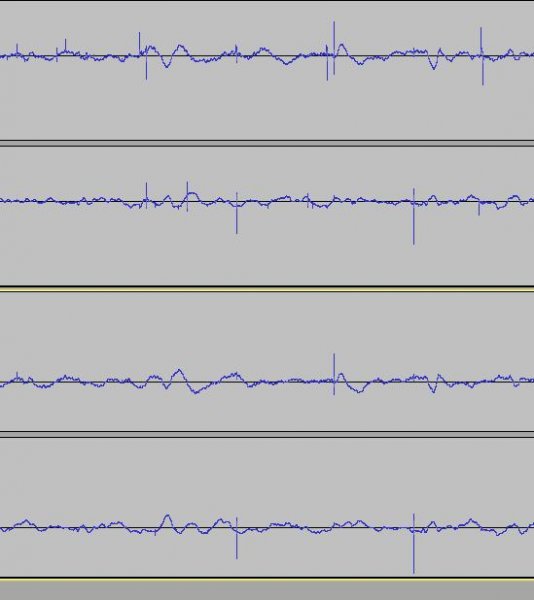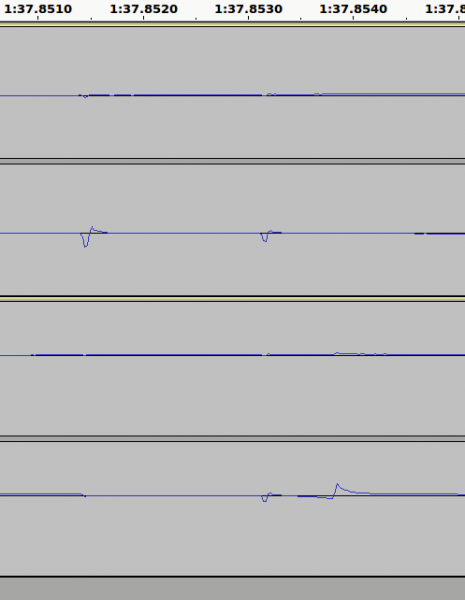I am writing to inform you of some fairly simple and cost-free techniques that I have used to evaluate the effectiveness of record cleaning. I would like to be able to fine-tune my own system or to buy another system on the basis of something better than just listening and guessing how much dirt is left.
With any system there are almost always some clicks left, which could be either dirt, or scratches or other defects. It's difficult to tell the difference. A subjective listening test is helpful but somewhat limited. It would be much better if we could quantite the amount of dirt remaining, and distinguish between dirt and permanent defects.
Furthermore, every record cleaning system, whether expensive or inexpensive, has dedicated users who attest to wonderful results. But that's not very helpful for comparison, because you can find good or bad reviews for just about any system. I'm pretty sure that you can get pretty good results from any system. The problem with almost all of these reviews is that I doubt whether they can distinguish between remaining dirt and defects.
Fortunately, any turntable can be used as a scanning probe microscope that feels the groove and faithfully records every little defect. You just need to digitize the record as you play it. I call this the Groove Probe.
The Groove Probe can be used for visual examination of the sound file, which, depending how you use it, can be quite revealing and diagnostic. Also, there is software available that can be used to count pops and clicks. This allows quanitification.
As an example, the first figure shows an excerpt of sound files from a very noisy record that has been cleaned.* The top two channels show the first playing after cleaning (L and R channels). The bottom two channels show the third playing. To make it easy to see defects and dirt, I looked at the (supposedly) silent tracks between bands.

Pops and clicks can easily be seen in all the tracks, which are due to both dirt and permanent defects. Two features are immediately apparent. First, the record grooves were much cleaner after being played twice, and many of the defects are missing from the third playback. Evidently there was quite a bit of dirt and debris still in the grooves, but it was moved or removed by the needle. Second, there are some residual defects that are essentially unaffected after being played twice. Since the needle didn't move them or alter them substantially, I believe these are defects in the plastic, and not dirt. Notice that the dirt and defects look quite similar, and they can be distinguished only because the needle moved the dirt.
The second figure also shows another short excerpt after one and three plays. Here you can see one permanent defect, one piece of dirt that was removed, and one piece of dirt that was moved or redeposited.

Here is a count of the pops and clicks detected.
Results:
1st play:
12544 left
18288 right
4482940 total samples
3rd play
8758 left
13452 right
4482940 total samples
The needle has removed 26 to 30% of the dirt after two plays. This seems consistent with the visual evidence. I could also have presented data from before and after cleaning.
=====
* Methods
The LP was wet-cleaned, brushed on the platter with a carbon brush, and digitized with a clean needle and a CD recorder. An excerpt was played three times without moving the record. The first and third times were recorded. The sound file was examined by Audacity (free, open-source program). A second stereo track was added, so that two separate playbacks could be compared. Audacity allows you to move one stereo track by dragging so the tracks could aligned and compared visually.
Identical excerpts from the two sound files were examined by ClickRepair (a commercial program with a free trial period). Clicks were removed in default stereo mode, and the number of clicks removed was recorded.
With any system there are almost always some clicks left, which could be either dirt, or scratches or other defects. It's difficult to tell the difference. A subjective listening test is helpful but somewhat limited. It would be much better if we could quantite the amount of dirt remaining, and distinguish between dirt and permanent defects.
Furthermore, every record cleaning system, whether expensive or inexpensive, has dedicated users who attest to wonderful results. But that's not very helpful for comparison, because you can find good or bad reviews for just about any system. I'm pretty sure that you can get pretty good results from any system. The problem with almost all of these reviews is that I doubt whether they can distinguish between remaining dirt and defects.
Fortunately, any turntable can be used as a scanning probe microscope that feels the groove and faithfully records every little defect. You just need to digitize the record as you play it. I call this the Groove Probe.
The Groove Probe can be used for visual examination of the sound file, which, depending how you use it, can be quite revealing and diagnostic. Also, there is software available that can be used to count pops and clicks. This allows quanitification.
As an example, the first figure shows an excerpt of sound files from a very noisy record that has been cleaned.* The top two channels show the first playing after cleaning (L and R channels). The bottom two channels show the third playing. To make it easy to see defects and dirt, I looked at the (supposedly) silent tracks between bands.

Pops and clicks can easily be seen in all the tracks, which are due to both dirt and permanent defects. Two features are immediately apparent. First, the record grooves were much cleaner after being played twice, and many of the defects are missing from the third playback. Evidently there was quite a bit of dirt and debris still in the grooves, but it was moved or removed by the needle. Second, there are some residual defects that are essentially unaffected after being played twice. Since the needle didn't move them or alter them substantially, I believe these are defects in the plastic, and not dirt. Notice that the dirt and defects look quite similar, and they can be distinguished only because the needle moved the dirt.
The second figure also shows another short excerpt after one and three plays. Here you can see one permanent defect, one piece of dirt that was removed, and one piece of dirt that was moved or redeposited.

Here is a count of the pops and clicks detected.
Results:
1st play:
12544 left
18288 right
4482940 total samples
3rd play
8758 left
13452 right
4482940 total samples
The needle has removed 26 to 30% of the dirt after two plays. This seems consistent with the visual evidence. I could also have presented data from before and after cleaning.
=====
* Methods
The LP was wet-cleaned, brushed on the platter with a carbon brush, and digitized with a clean needle and a CD recorder. An excerpt was played three times without moving the record. The first and third times were recorded. The sound file was examined by Audacity (free, open-source program). A second stereo track was added, so that two separate playbacks could be compared. Audacity allows you to move one stereo track by dragging so the tracks could aligned and compared visually.
Identical excerpts from the two sound files were examined by ClickRepair (a commercial program with a free trial period). Clicks were removed in default stereo mode, and the number of clicks removed was recorded.






